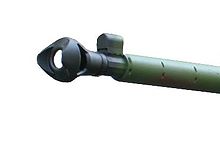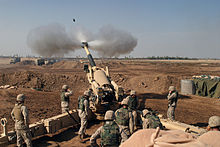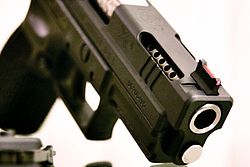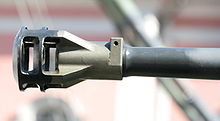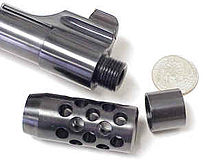- Muzzle brake
-
Muzzle brakes and recoil compensators are devices that are fitted to the muzzle of a firearm or cannon to redirect propellant gases with the effect of countering both recoil of the gun and unwanted rising of the barrel during rapid fire.[1] Muzzle brakes are very useful for combat and timed competition shooting, and are commonly found on rifles firing very large cartridges (often big-game rifles), as well as some artillery and tank guns. They are also commonly used on pistols for practical pistol competitions, and are usually called compensators in this context.[2]
Contents
Terminology
The term muzzle brake was introduced in the context of artillery, but it is also used for rifles and pistols. It defines a device that reduces the recoil of the weapon by directing the propellant gases backwards. The force generated at the muzzle brake baffles or ejector ports acts in the opposite direction to the force of recoil, thus reducing wear on the recoil-damping mechanism and allowing a lighter design. In the case of smaller caliber firearms such as rifles it reduces the effects of kickback on the shooter.
The terms recoil brake and recoil check are seldom used and never in artillery parlance. The terms recoil compensator, compensator, Mag-na-port and others belong to shooters' lingo and refer to devices that serve to direct propellant gases upwards to reduce muzzle climb and to some extent also the recoil in hand firearms like pistols and revolvers, and also in small-calibre automatic weapons like assault rifles, PDWs etc. With the exception of names for proprietary systems, such as Mag-na-porting and hybrid compensators, and brand names such as Muzzle Tamer, the various terms in the hand firearm parlance are used interchangeably.[3][4][5][6][7][8][9][10]
Muzzle rise or climb
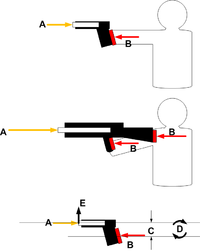 Illustration of forces in muzzle rise. Projectile and propellant gases act on barrel along barrel centerline A. Forces are resisted by shooter contact with gun at grips and stock B. Height difference between barrel centerline and average point of contact is height C. Forces A and B operating over moment arm / height C create torque or moment D, which rotates the firearm's muzzle up as illustrated at E.
Illustration of forces in muzzle rise. Projectile and propellant gases act on barrel along barrel centerline A. Forces are resisted by shooter contact with gun at grips and stock B. Height difference between barrel centerline and average point of contact is height C. Forces A and B operating over moment arm / height C create torque or moment D, which rotates the firearm's muzzle up as illustrated at E.
The interchangeable terms muzzle rise, muzzle flip, or muzzle climb refer to the tendency of a firearm's front end (the muzzle end of the barrel) to rise up after firing.
The primary reason for muzzle rise is that for nearly all firearms, the centerline of the barrel is above the center of contact between the shooter and the firearms' grips and stock. The forces from the bullet being fired and the propellant gases exiting the muzzle act directly down the centerline of the barrel. If that line of force is above the center of the contact points, this creates a moment or torque rotational force. That torque causes the firearm to rotate, and the muzzle end to rise upwards. The M1946 Sieg automatic rifle had an unusual Muzzle brake that made the rifle climb downwards, but enabled the user to fire it with one hand in full automatic.
Firearms with less height from the grip line to the barrel centerline will tend to experience less muzzle rise.
Concept
Muzzle brakes are simple in concept. One of the simplest designs can be found on U.S. 90 mm tank guns as used on the M47 Patton tank. This consists of a small length of tubing mounted at right angles to the end of the barrel. Brakes most often utilize slots, vents, holes, baffles, and similar devices. The strategy of a muzzle brake is to redirect and control the burst of combustion gases that follows the departure of a projectile.
In conventional muzzle brake designs, combustion gases depart the muzzle brake at an angle (or direction) to the muzzle. This creates a force which helps to counteract the rearward movement of the barrel (due to recoil) as well as the upward rise of the muzzle. The effect can be compared to reverse thrust systems on aircraft jet engines. The mass and velocity of the gases is significant enough to move the firearm in the opposite direction of recoil. On the AKM assault rifle, the brake is angled slightly to the right to counteract the sideways movement of the gun under recoil.
Another method of redirecting gases is called porting. Porting involves creating ports or holes that are precision-drilled into the forward part of the barrel (and slide on pistols). These holes are designed to divert a portion of the gases expelled prior to the departure of the bullet in the direction that reduces the tendency of the firearm to flip upwards.[11] The concept applies Newton's third law: the exhaust directed upward causes a reciprocal force downward. Porting is most commonly used on shotguns, where recoil is most significant and makes rapid firing difficult. Even single shots of magnum-strength loads are uncomfortable for all but the most seasoned shooters. Porting has obvious advantages for faster follow-up shots, especially for 3-round burst operation.[citation needed]
Another strategy (besides redirecting gases) for counteracting muzzle rise involves slowing the departure of combustion gases. Slowing of the gases is the method used on suppressors and linear compensators.[12]
Construction
Construction of a brake or compensator can be very simple; for example, some models of the AK-47 used a diagonal cut at the muzzle end of the barrel to direct some of the escaping gases upwards. Another simple method is porting, where holes or slots are machined in the barrel near the muzzle to allow the gas to escape.[13]
More advanced designs use baffles and expansion chambers to slow down the escaping gases; this is the basic principle behind a linear compensator. Ports are often added to the expansion chambers, producing the long, multi-chambered recoil compensators often seen on IPSC raceguns.[2]
Utility
There are advantages and disadvantages to muzzle brakes. Recoil is a subjective concept. One shooter may perceive it as pain, another as movement of the sights, and another as rearward thrust. Recoil energy can be sharp if the impulse is fast or may be considered soft if the impulse is slower, even if the same total energy is transferred.[14]
Advantages of muzzle brakes
Though there are numerous ways of measuring the energy of a recoil impulse, it's generally true that between a 10% and 50% reduction can be measured. There are, however, muzzle brake manufacturers that claim greater recoil reduction percentages.[15] Muzzle brakes need sufficient propellant gas volume and high gas pressure at the muzzle of the gun to achieve good measured recoil reduction percentages. This means cartridges with a large bore area to case volume ratio combined with a high operating pressure benefit more from recoil reduction with muzzle brakes than smaller standard cartridges.
Besides reducing felt recoil, one of the primary advantages of a muzzle brake is the reduction of muzzle rise. This allows a weapon's sights to be realigned more quickly. This is relevant particularly for fully automatic weapons. Muzzle rise is often entirely eliminated[citation needed] by an efficient design. Because the rifle moves rearward less, the shooter has little to compensate for. This is particularly true of rapid-fire, fully automatic fire, and large-bore hunting rifles. They are also common on small-bore vermin rifles, where reducing the muzzle rise allows the shooter to see the bullet impact through a telescopic sight. A reduction in recoil also reduces the chance of undesired (painful) contacts between the shooter's head and the ocular of a telescopic sight or other aiming components that have to be positioned near the shooter's eye (often referred to as "scope eye"). Another advantage of a muzzle brake is a reduction of recoil fatigue during extended practice sessions, enabling the shooter to consecutively fire more rounds accurately. Further, flinch (involuntary pre trigger release anxiety behaviour resulting in inaccurate aiming and shooting) caused by excessive recoil may be significantly reduced or eliminated with certain shooters.
Disadvantages of muzzle brakes
The advantages of brakes and compensators are not without cost, however. The most obvious of these to the shooter or gun crew is the perceived increase in sound pressure level as well as the increase in muzzle blast and lead exposure for the shooter and any nearby bystanders. This occurs because the sound, flash, pressure waves and lead loaded smoke plume normally projected largely away from the shooter are now partially redirected outwards to the side or even at backward angles towards the shooter or gun crew. While eye and ear protection should always be used when shooting, even this may not help enough to avoid hearing damage with the muzzle blast directed back towards the shooter or gun crew.
Noise
Measurements indicate that on a rifle a muzzle brake adds 5 to 10 dB to the normal noise level perceived by the shooter, increasing total noise levels up to 160 dB(A) +/- 3 dB.[16] Painful discomfort occurs at approximately 120 to 125 dB(A),[17] with some references claiming 133 dB(A) for the threshold of pain.[18] Active ear muffs are available with electronic noise cancellation that can reduce direct path ear canal noise by approximately 17-33 dB, depending on the low, medium, or high frequency at which attenuation is measured.[19] Passive ear plugs vary greatly in their measured attenuation, ranging from approximately 20 dB to 30 dB, depending on whether or not they are properly used.[20] Using both ear muffs (whether passive or active) and ear plugs simultaneously is a practice that is often used for obtaining the maximum protection, but the efficacy of such combined protection relative to preventing permanent ear damage is not conclusive, with evidence indicating that a combined noise reduction ratio (NRR) of only 36 dB (C-weighted) is the maximum possible using ear muffs and ear plugs simultaneously, equating to only a 36 - 7 = 29 dB protection against a 160 dB(A) noise level.[18] Relative to a noise level of 160 dB(A), this means that even using ear muffs and ear plugs simultaneously cannot protect a shooter against permanent ear damage when using a muzzle brake, through leaving a shooter exposed to noise levels of approximately 131 dB(A) that is 11 dB above the point where permanent ear damage occurs.
In the European Union (EU), employees are protected by law against impulsive or impact noise exposure over 137 dB(A), with an absolute limit of 140 dB(A).[21][22] Individual member states often define even lower levels by national law; the United Kingdom, for instance, opted for 120 dB(A), which is where many references indicate that permanent ear damage occurs. The duration of exposure is likewise limited, for environmental noise above 90 dB(A) in the United States by OSHA rules, and for environmental noise above 80 dB(A) in the European Union, for exposure over an entire work day. The EU legislation demands the noise has to be reduced at the origin in the technically best possible way. Professional small arms and artillery users such as military and police personnel, etc., have to be issued with adequately working suppressors or hearing protection to reduce noise to levels as defined by law, since an employer has to anticipate legal action and compensations in cases where an employee that used the provided protective gear suffers work-induced health damage.
Bulk
Brakes and compensators are additionally often quite bulky, adding length, diameter, and mass to the muzzle end of the firearm, where it will most influence its handling. Further, flinch caused by blast induced sinus cavity concussion discomfort experienced by the shooter can become a problem for anti-materiel rifle shooters due to the big cartridges these rifles fire.
Visibility
A serious tactical disadvantage of muzzle brakes on both small arms and artillery is that, depending on their designs, they may cause escaping gases to throw up dust and debris clouds that impair visibility and reveal one's position, not to mention posing a hazard to individuals without eye protection. Troops often wet the ground in front of antitank guns in defensive emplacements to prevent this, and snipers are specially trained in techniques for suppressing or concealing the magnified effects of lateral muzzle blast when firing rifles with such brakes. Linear compensators and suppressors do not have the disadvantages of a redirected muzzle blast; they actually reduce the blast by venting high pressure gas forward at reduced velocity.
Legality
 Flash suppressor of the SIG SG 550 rifle. Flash suppressors are often designed to work as simple muzzle brakes.
Flash suppressor of the SIG SG 550 rifle. Flash suppressors are often designed to work as simple muzzle brakes.
Muzzle brakes were ruled "legal" by the ATF in the United States a short time after the now defunct Federal assault weapons ban went into effect in 1994. These muzzle attachments were legal to attach to a threaded barrel, so long as they were welded in place on certain firearms (high temperature silver solder also sufficed). On the other hand, flash suppressors and barrel shrouds were seen as 'military' features, and were on the list of features that, provided enough features were present, defined the rifle as illegal, if manufactured after the effective date of the ban. This meant, in practice, muzzle brakes had to be certified by the ATF to prevent end-users from accidentally violating the law and installing a device that could later be found to be defined legally as being more of a flash suppressor than a muzzle brake, even if marketed and sold as a muzzle brake, if incidental flash suppression was deemed to be 'significant' by the ATF. The Federal laws governing this expired in 2004, and are no longer of active concern, except in those few jurisdictions in which certain provisions are still retained in specific state laws.
In some African jurisdictions where big game hunting is commonplace, rifles (typically firing extremely powerful loads) equipped with muzzle brakes are banned due to hearing damage hazard to scouts and guides without hearing protection. [23]
See also
References
- ^ Muzzle brake in the NRA Firearms Glossary
- ^ a b STI article on Limcat Undergas Bypass Turbo System recoil compensator
- ^ "SAAMI Glossary, Compensator". http://saami.org/Glossary/display.cfm?letter=C.
- ^ "Definition for "compensator"". MidwayUSA GunTec Dictionary. http://www.midwayusa.com/guntecdictionary.exe/showterm?TermID=1860.
- ^ "Definition for "muzzle compensator"". MidwayUSA GunTec Dictionary. http://www.midwayusa.com/guntecdictionary.exe/showterm?TermID=3448.
- ^ "Definition for "recoil brake"". MidwayUSA GunTec Dictionary. http://www.midwayusa.com/guntecdictionary.exe/showterm?TermID=3997.
- ^ "1911 AUTO .355" THREADED HYBRID BARREL". http://www.brownells.com/aspx/NS/store/productdetail.aspx?p=12689.
- ^ "The Mag-na-port Process: Handgun Porting". http://www.magnaport.com/hgun.html.
- ^ "Thompson/Center Custom Shop, Barrel Configurations". http://www.tcarms.com/customShop/chart_options.php.
- ^ Recoil Check
- ^ "Jump Is Taken Out Of Guns By Cylinders On Muzzle" Popular Mechanics, August 1932
- ^ LeVang linear compensator
- ^ Mag-Na-Port handgun porting information
- ^ A muzzle brake manufacturer on pros and cons and recoil reduction of muzzle brakes
- ^ PGRS-1 muzzle brake article
- ^ Summary of a Finnish government report (1992) on silencers, muzzle brakes and noise levels
- ^ (German) and (English) Schalldämpfer = Gehörschützer für Jäger, data collected on noise levels
- ^ a b Hearing Protection Basics
- ^ Peltor Active Muffs data sheet
- ^ Finnish Research paper
- ^ Acoustic Regulations
- ^ DIRECTIVE 2003/10/EC OF THE EUROPEAN PARLIAMENT AND OF THE COUNCIL of 6 February 2003 on the minimum health and safety requirements regarding the exposure of workers to the risks arising from physical agents (noise)
- ^ http://www.chuckhawks.com/muzzle_brakes.htm
External links
Categories:- Firearm components
- Artillery components
Wikimedia Foundation. 2010.

